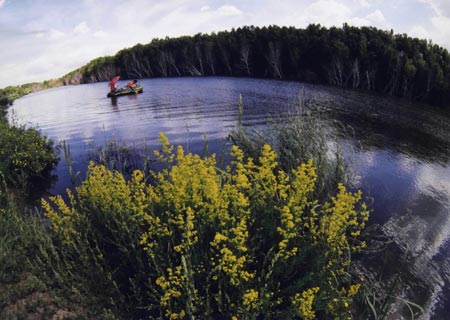China has a vast territory, with abundant natural resources and diverse types of land resources. Its waterpower resources rank first worldwide. It is one of the countries in the world having the most species of wild animals, and has almost all kinds of vegetation found in the Northern Hemisphere. It has abundant mineral resources, with a great variety of minerals.
Land Resources
China's land resources exhibit the following basic features: The land resources are large in absolute terms but small on a per-capita basis. There are more mountains than plains, with cultivated land and forests constituting small proportions. Various types of land resources are unevenly distributed among different regions. The cultivated land is mainly in plains and basins in the monsoon regions of east China, while forests are mostly found in the remote mountainous areas in the northeast and the southwest. Grasslands are chiefly distributed on inland plateaus and in mountains.
 |
China enjoys a rich variety of land resources. Pictured are beautiful paddy terraces in Guiyang, capital city of Guizhou Province.
Cultivated Land According to the Agricultural Census in 1996, China has 130.04 million hectares of cultivated land and 35.35 million hectares of land suitable for agricultural uses.
The cultivated land is mainly distributed in the Northeast China, North China and Middle-Lower Yangtze plains, the Pearl River Delta and the Sichuan Basin. The fertile land in the Northeast China Plain is chiefly planted with wheat, corn, sorghum, soybean, jute and ambary hemp, and sugar beet. Farm crops planted in the North China Plain include wheat, corn, millet, sorghum, cotton and peanut. The Middle-Lower Yangtze Plain produces rice, orange and rapeseed, while the Sichuan Basin abounds in rice, rapeseed, sugarcane, orange, grapefruit, tea, etc.
China's cultivated land is diminishing. Statistics from the Ministry of Land and Resources and the National Bureau of Statistics show that more than 6.6 million hectares of cultivated land were lost from 1996 to 2004, representing an annual reduction of over 670,000 hectares. In the recent couple of years, the state has adopted the strictest ever land management policies, which helped to check the loss of the cultivated land. However, the annual reduction remained considerable. According to the statistical communique released by the National Bureau of Statistics, the year 2006 saw 167,000 hectares of farmland actually used for construction, some 36,000 hectares of cultivated land were destroyed by disasters, a total of 339,000 hectares of farmland were converted into land for ecological preservation, structural adjustment in agricultural production led to a reduction of 40,000 hectares of cultivated land and non-reported use of 91,000 hectares farmland for construction purposes from previous years was revealed. Land reclamation and re-development projects added over 367,000 hectares of cultivated land. As a result, the year saw a net reduction of 306,000 hectares of cultivated land.
Forests The sixth national enumeration of forest resources (1999-2003) demonstrated that the total forest area was 175 million hectares, and the forest coverage rate was 18.21 percent. The total standing stock volume was 13.62 billion cubic meters, and the stock volume of the forest was 12.46 billion cubic meters.
Natural forests are concentrated in the northeast and the southwest, but scarce in the densely inhabited and economically developed eastern plains and the vast northwestern region.
 |
A majority of China's natural forests are scattered in the northeastern and southwestern regions. Pictured is the luxuriant Huanglianggang National Forest Park in Inner Mongolia.
The forests in China are rich in tree species, with the number of arbor species alone exceeding 2,800. Rare and peculiar species include ginkgo and metasequoia (dawn redwood). In order to conserve environment and meet the needs of economic development, China has launched large-scale afforestation campaigns. The area of planted forests has reached 33.79 million hectares, accounting for 31.86 percent of the nation's total forest area, making China a country with the largest area of planted forests in the world.
The total area of forests created in 2006 was 4.57 million hectares, of which 2.52 million hectares were planted forests. Some 2.97 million hectares were created through key afforestation projects, accounting for 65 percent of the total. Some 1.89 billion trees were planted in national voluntary tree-planting programs. By the end of 2006, 233 national-level ecological demonstration zones had been designated. The number of nature reserves reached 2,395, of which 265 were at national level. The area of nature reserves was 151.54 million hectares, or 15 percent of the total land area of China. About 42,000 square km of eroded land were put under comprehensive treatment, and 62,000 square km of land were closed for water and soil preservation.
Northeast China Forest Zone Located in the Greater and Lesser Hinggan Mountains and the Changbaishan Mountains, it is the largest natural forest area in China, with its forest coverage and timber reserves accounting for over one third of the national totals. The area turns out half of the national total timber output. Chief tree species include larch and Korean pine.
Southwest China Forest Zone China's second largest natural forest area, it consists of forests in the Hengduanshan Mountains, on the southern slopes of the Himalayas and in the area at the U-turn of the Yarlung Zangbo River. Its forest reserves make up one third of the national total. Main tree species include fir, red sandal and nanmu.
Southeast China Forest Zone Comprising mainly planted forests, it covers the vast hilly areas south of the Qinling-Huaihe line and east of the Yunnan-Guizhou Plateau. Economic tree species are mainly planted in the zone, such as tea shrub, moso bamboo, masson pine and lacquer tree.
Shelter-forests In a bid to resist sandstorms and prevent soil erosion, China has constructed many shelter-forests, such as the three-north (northeast, north and northwest China) shelterbelt, shelter-forests along the middle and upper reaches of the Yangtze River, coastal shelterbelt networks, afforestation project in the Taihangshan Mountains and the plain afforestation project. Of these, the three-north shelterbelt under construction, which is regarded as “the world's greatest ecological project,” will extend more than 7,000 km and cover 260 million hectares, accounting for a quarter of China's total land area.
Grassland China has 400 million hectares of grassland, with those of economic value accounting for 313.33 million hectares. China is one of the countries with the largest area of pasturelands in the world. Natural pasturelands are mainly distributed in areas west and north of the Greater Hinggan Mountains, the Yinshan Mountain and the eastern foot of the Qinghai-Tibet Plateau, while artificial pasturelands are concentrated in southeast China.
Four Major Grassland Areas
Inner Mongolia Grassland Area The largest in China, it produces such fine breeds as Sanhe horse and Sanhe cattle.
 |
China ranks first in the world in terms of grassland area. Pictured is the Inner Mongolia Grassland.
Xinjiang Grassland Area Fine breeds in the area include Xinjiang fine-wool sheep, Altay big-tail sheep and Ili horse.
Qinghai Grassland Area A main yak-producing area, the area also breeds the world-famous Hequ horse.
Tibet Grassland Area It is a main yak-producing area.










